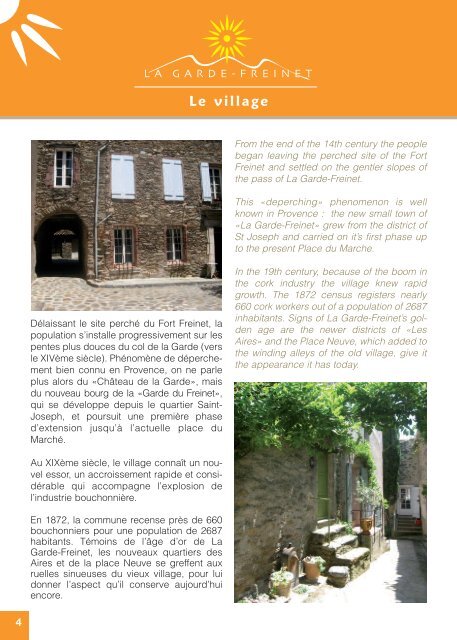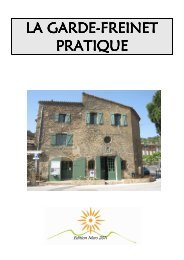livret la garde - Office du tourisme de la Garde-Freinet
livret la garde - Office du tourisme de la Garde-Freinet
livret la garde - Office du tourisme de la Garde-Freinet
You also want an ePaper? Increase the reach of your titles
YUMPU automatically turns print PDFs into web optimized ePapers that Google loves.
L e v i l <strong>la</strong>geFrom the end of the 14th century the peoplebegan leaving the perched site of the Fort<strong>Freinet</strong> and settled on the gentler slopes ofthe pass of La Gar<strong>de</strong>-<strong>Freinet</strong>.This «<strong>de</strong>perching» phenomenon is wellknown in Provence : the new small town of«La Gar<strong>de</strong>-<strong>Freinet</strong>» grew from the district ofSt Joseph and carried on it’s first phase upto the present P<strong>la</strong>ce <strong>du</strong> Marche.Dé<strong>la</strong>issant le site perché <strong>du</strong> Fort <strong>Freinet</strong>, <strong>la</strong>popu<strong>la</strong>tion s’installe progressivement sur lespentes plus douces <strong>du</strong> col <strong>de</strong> <strong>la</strong> Gar<strong>de</strong> (versle XIVème siècle). Phénomène <strong>de</strong> déperchementbien connu en Provence, on ne parleplus alors <strong>du</strong> «Château <strong>de</strong> <strong>la</strong> Gar<strong>de</strong>», mais<strong>du</strong> nouveau bourg <strong>de</strong> <strong>la</strong> «Gar<strong>de</strong> <strong>du</strong> <strong>Freinet</strong>»,qui se développe <strong>de</strong>puis le quartier Saint-Joseph, et poursuit une première phased’extension jusqu’à l’actuelle p<strong>la</strong>ce <strong>du</strong>Marché.In the 19th century, because of the boom inthe cork in<strong>du</strong>stry the vil<strong>la</strong>ge knew rapidgrowth. The 1872 census registers nearly660 cork workers out of a popu<strong>la</strong>tion of 2687inhabitants. Signs of La Gar<strong>de</strong>-<strong>Freinet</strong>’s gol<strong>de</strong>nage are the newer districts of «LesAires» and the P<strong>la</strong>ce Neuve, which ad<strong>de</strong>d tothe winding alleys of the old vil<strong>la</strong>ge, give itthe appearance it has today.Au XIXème siècle, le vil<strong>la</strong>ge connaît un nouvelessor, un accroissement rapi<strong>de</strong> et considérablequi accompagne l’explosion <strong>de</strong>l’in<strong>du</strong>strie bouchonnière.En 1872, <strong>la</strong> commune recense près <strong>de</strong> 660bouchonniers pour une popu<strong>la</strong>tion <strong>de</strong> 2687habitants. Témoins <strong>de</strong> l’âge d’or <strong>de</strong> LaGar<strong>de</strong>-<strong>Freinet</strong>, les nouveaux quartiers <strong>de</strong>sAires et <strong>de</strong> <strong>la</strong> p<strong>la</strong>ce Neuve se greffent auxruelles sinueuses <strong>du</strong> vieux vil<strong>la</strong>ge, pour luidonner l’aspect qu’il conserve aujourd’huiencore.4



